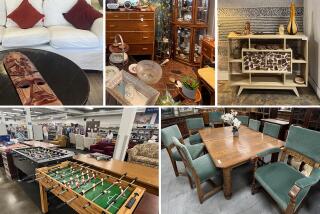Dinner-Party Centerpiece Spoke Volumes
- Share via
Dinner-party decorations have been relatively unchanged for centuries. Many a hostess has been faced with a large, long table that had nothing in the center. The void has been filled with attractive vases, epergnes, figurines and fruit and flowers.
The 17th century table featured large and small platters of food. The platters, often made of silver or gold, helped to declare the wealth and importance of the host.
The food on the platters was prepared to be decorative. A cooked peacock was served with its colorful feathers adorning the platter, for instance. Some cooked animals were presented using their head and feet as decorations.
Fresh flowers were not used until the 19th century, but flowers of porcelain or silk often were part of the decoration in the 18th century. Because decorations were meant to show one’s status, rare, make-believe decorations were preferred.
Large epergnes often were filled with fruit or dessert sweets in the center of the table.
The 19th century hostess preferred fresh fruit, foliage and flower centerpieces.
One writer suggested using a board for the table with a hole in the center. The hostess would place a tall plant beneath the hole so the leaves would form a large centerpiece.
Other hostesses used high stands decorated with greenery and flowers.
Tables continued to have large centerpieces in the 20th century. Etiquette suggested that the arrangements should be low so the dinner guests could talk across the table. The wealthy arranged fruit or low flowers in silver bowls with decorations of three-dimensional cherubs or animals. Those with less money used simple bowls.
Question: When I was a boy in the late 1930s, I sent in a Wheaties box top and got a Jack Armstrong ring with a stone set in it. What is the ring worth?
Answer: Jack Armstrong, the fictional “All-American Boy,” starred in a radio adventure serial that ran from 1933 to 1951.
A few Jack Armstrong premium rings were issued. Yours is the Dragon’s Eye ring offered on the back of Wheaties boxes about 1940. The ring, white-glow plastic with a dark green stone, was redeemed for one box top and 10 cents.
Today it is worth from $300 to $1,000, depending on condition.
Q: I saw a beaded purse at a flea market that had a double-hinged frame. It was flat when closed. When opened, the metal frame formed a square opening, and the purse hung down. The purse had a geometric, almost Indian design. The dealer said it was at least 80 years old. A: The double-hinged folding purse frame became popular in Paris about 1910. American makers immediately started using the newly fashionable frames.
Beaded bags were made by American Indians in the early part of this century. They usually were made of chamois and colorful beads that were a bit larger than those made by the purse-making companies. Traditional Indian patterns were used and soon copied by others.
Transfer patterns were available that could be used on homemade beaded bags.
The purses made by the Indians usually did not have a commercial metal frame.
Q: My sister rescued my 1950s 8-inch little-girl doll from our mother’s attic. It looks like a Ginny doll, but it’s not marked “Ginny” or “Vogue.” It has no mark. Can you tell me anything?
A: Ginny dolls were introduced in 1951 by Vogue Dolls Inc. of Medford, Mass.
The doll started a trend. Other companies across the country began making 8-inch toddler dolls with dozens of interchangeable outfits. The knockoff dolls were less expensive than Ginny, and most of them were unmarked.
Today, collectors like the knock offs because many of them are well-made, attractive dolls and less expensive than Ginny.
Your doll, clean, dressed and in excellent condition, would sell for $20 to $50. A Ginny doll from the mid-’50s is worth more than $100.
Q: I need to have a custom-sized box spring and mattress made for my walnut Victorian three-quarter-sized bed. How much smaller than the bed should the mattresses be?
A: Measure the distance between the headboard and footboard and between both sideboards. Mattress companies subtract an inch or so from each of those measurements to make a mattress that will fit. Give the company the minimum measurements you will accept.
There should be less than 2 inches of space between the bed and the end of the mattress.
If you wish other information about antiques, include a self-addressed, stamped (55 cents) envelope, and the Kovels will send you a listing of helpful books and publications. Write to the Kovels, The Los Angeles Times, King Features Syndicate, 235 E. 45th St., New York, NY 10017.
(BEGIN TEXT OF INFOBOX / INFOGRAPHIC)
Current Prices
Current prices are recorded from antiques shows, flea markets, sales and auctions throughout the United States. Prices vary because of local economic conditions.
* Colorado Mountain Playgrounds booklet, Union Pacific Railroad, 1927, 48 pages: $30.
* Moxie celluloid fan, ribbons connect blades, “Moxie” on each blade, black lettering on white, 1920s: $55.
* Franciscan salt-and-pepper shaker, Apple pattern: $75.
* Dick Tracy Detective Club shield, brass, embossed, eagle at top, leather pouch, 1937, 3x3 inches: $110.
* Sargent & Foster apple peeler, iron, wooden base, 1859s: $225.
* Amish patchwork quilt, Sunshine and Shadow pattern, yellow cotton, brown trim, circa 1910, 84x81 inches: $450.
* Rookwood Vellum vase, landscape, blue, pink and green, impressed logo, 1919, 10 3/4 inches: $975.
* Charles Eames lounge chair and ottoman, rosewood shell, black leather, 1970, signed, 32 1/2 x 32 x 29 inches: $1,150.
* Steiff teddy bear, silver, squeaker, black glass eyes, brown stitched nose, 1920s, 17 inches: $1,950.
More to Read
Eat your way across L.A.
Get our weekly Tasting Notes newsletter for reviews, news and more.
You may occasionally receive promotional content from the Los Angeles Times.










